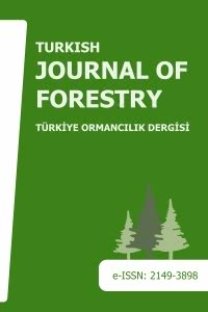Orman ekosistem çeşitliliği haritalama çalışmaları için ekolojik alan çeşitliliğinin belirlenmesi üzerine bir öneri
Ekosistem çeşitliliğinin belirlenmesi için biyolojik çeşitliliğin (tür çeşitliliği, yapısal çeşitlilik ve fonksiyonel çeşitlilik) ve genetik çeşitliliğin (taksonomik çeşitlilik) belirlenmesi gerekmektedir. Tür çeşitliliği alfa, beta ve gama düzeyinde belirlenmektedir. Yapısal çeşitliliğin hesabında boyutsal ölçüm farkınsallığı, türlerin mekânsal dağılım düzeni, tür karışım durumu oldukça değerli bilgiler vermektedir. Fonksiyonel çeşitlilik türlerin fonksiyonel benzemezliklerin toplamı olarak belirlenmektedir. Taksonomik çeşitlilik türlerin sistematik sınıflandırmasını içerdiğinden bu sınıflandırma genetik mesafe anlamını taşımaktadır. Farklı çeşitlilik sınıfların belirlenmesi ve bunlarının standardize verileri üzerinden tek değer hesabı bu durumda bize ekosistem çeşitliliğini belirlemek için ekolojik alan çeşitlilik değerini vermiş olacaktır. Bu çalışma ekosistem çeşitliğinin belirlenmesi için tür çeşitliliği, yapısal çeşitlilik, fonksiyonel çeşitlilik ve taksonomik çeşitlilik alanlarında kullanılan bazı indisler hakkında bilgi vermek amacıyla gerçekleştirilmiştir. Bu çeşitlilik indislerin standardize edilmiş değerleri üzerinden ekosistem çeşitliliğini belirlemeye yönelik ekolojik alan çeşitlilik değeri hesabı ise bu makalede önerilmiştir. Bu değer, ekosistemlerin enerjisini, sağlık durumunu, sürdürülebilirlik durumunu ve dayanımını toplu olarak ifadesi açısından önem arz etmektedir.
Anahtar Kelimeler:
ekosistem, bitki toplulukları, biyoçeşitlilik, ekolojik denge, orman ekolojisi, tür çeşitliliği
A succession for determination of ecologic area diversity index for forest ecosystem diversity mapping
Biodiversity (species diversity, structural diversity and functional diversity) and genetic diversity (taxonomic diversity and/or taxonomic differentiation) have to be calculated in order to define ecosystem diversity. Species diversity is calculated at the level of alpha, beta and gamma. Dealing with calculation of structural diversity, size differentiation, contagion, species mingling give valuable information. Functional attribute diversity is the sum of the pairwaise functional dissimilarities of species. Taxonomic diversity based on systematic species classification can be recognized as genetic diversity. This article was written to give information about some important indices including species diversity, structural diversity, functional diversity and genetic diversity in order to define ecological area diversity intended for identification of ecosystem diversity. Obtained a numerical value from standardized values of all kind of diversities for a given sample plot, was suggested as ecological area index for calculation of ecosystem diversity in the study. This value is very important to summarize performance, healthy, sustainability and resilience of ecosystems.
Keywords:
ecosystems, plant communities, biodiversity, ecological balance, forest ecology, species diversity,
___
Gadow, K.V., Hui, G.Y., 1999. Modelling forest development. Kluwer Academic Publishers, Dordrecht, 213p.Gillison, A.N., Carpenter, G., 1997. A generic plant functional attribute set and grammar for dynamic vegetation description and analysis. Functional Ecology, 11:775-783.
Gülsoy, S., Özkan, K., 2008. Tür çeşitliliğinin ekolojik açıdan önemi ve kullanılan bazı indisler. SDÜ Orman Fakültesi Dergisi, 1:168-178.
IPPC, 2007. Summary for Policymakers. In: Climate Change 2007: The Physical Science Basis. Contribution of Working Group I to the Fourth Assessment Report of the Intergovernmental Panel on Climate Change [Solomon, S., D. Qin, M. Manning, Z. Chen, M. Marquis, K.B. Averyt, M. Tignor and H.L. Miller (eds.)]. Cambridge University Press, Cambridge, United Kingdom and New York, NY, USA.
Jeglum, J.K., He, F., 1995. Pattern and vegetation-environment relationships in a boreal forested wetland in northeastern Ontorio. Canadian Journal of Botany, 73:629-637.
Özkan, K., 2009. Yaban hayati ekolojisi'nde analitik değerlendirme açısından uygun envanter metodu üzerine bir öneri. SDÜ Orman Fakültesi Dergisi, 2:160-169.
Özkan, K., Senol, H., Gulsoy, S., Mert, A., Suel, H., Eser, Y., 2009. Vegetation-environment relationships in Mediterranean mountain forests on limeless bedrocks of southern Anatolia, Turkey. Journal of Environmental Engineering and Landscape Management, 17(3):154-163.
Petchey, O.L., Gaston K. J., 2006. Functional diversity: back to basics and looking forward. Ecology Letters, 9: 741-758.
Petchey O.L, Hector A., Gaston K.J., 2004. How do different measures of functional diversity perform? Ecology, 85: 847-857.
Pielou, E.C., 1975. Ecological diversity. John Wiley Publications, 165p., New York.
Ripley B.D., 1981. Spatial Statistics. John Wiley Publications, 252p., New York.
Schmera, D., Eros, T., Podani, J., 2009. A measure for assessing functional diversity in ecological communities. Aquat. Ecol., 43(1):157-167.
Vorčák, J., Merganic, J., Saniga, M., 2006. Structural diversity change and regeneration processes of the Norway spruce natural forest in Babia hora NNR in relation to altitude. Journal of Forest Science, 52(9):399-409.
Walker, B, Kinzig, A.P, Langride, L., 1999. Plant attribute diversity, resilience, and ecosystem function: the nature and significance of dominant and minor species. Ecosystems, 2:95-103.
Warwick, R.M, Clarke, K.R., 1995. New biodiversity measures reveal a decrease in taxonomic distinctness with increasing stress. Marine Ecology Progress Series, 129:301-305.
Wilson, M.V, Shmida, A, 1984. Measuring beta diversity with presence-absence data. Journal of Ecology, 72:1055-1064.
- ISSN: 1302-7085
- Yayın Aralığı: Yılda 2 Sayı
- Başlangıç: 2000
Sayıdaki Diğer Makaleler
Physical and mechanical properties of athel wood (Tamarix aphylla)
George I. MANTANIS, Dimitrios BIRBILIS
Kızılçam’da (pinus brutia ten.) odun yoğunluğunun X-ray yoğunluk ölçer ile belirlenmesi
SÜLEYMAN GÜLCÜ, Sultan Çelik UYSAL
Akdeniz tipi ekosistemlerde yangın sonrası vejetasyon dinamiği
Ali KAVGACI, ÇAĞATAY TAVŞANOĞLU
Şehir içi ağaçlandırmalarda kavakların (populus l.) kullanılması: Kahramanmaraş örneği
Köprülü Kanyon Milli Parkı (Antalya) karayosunu florasına katkılar
Köpüklü kompozit (sandviç) levhaların bazı teknolojik özellikleri
